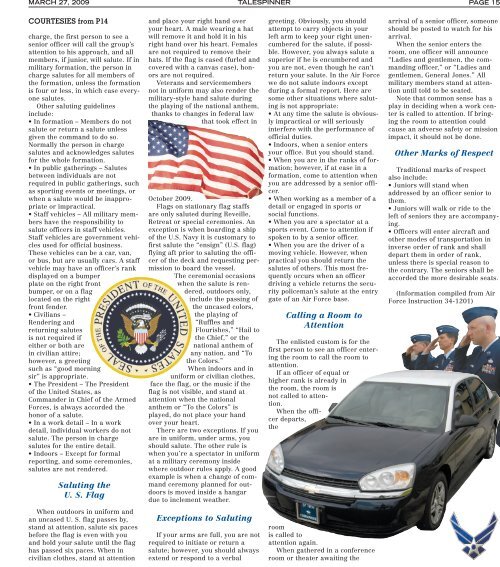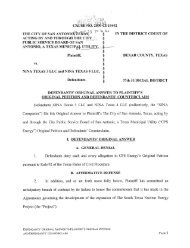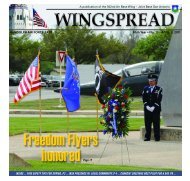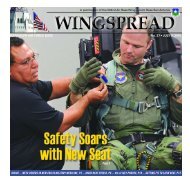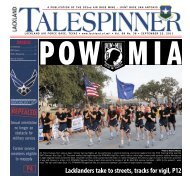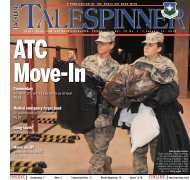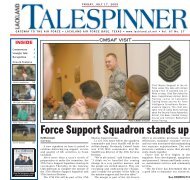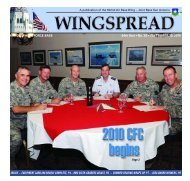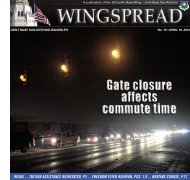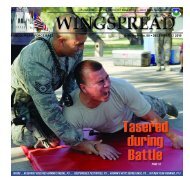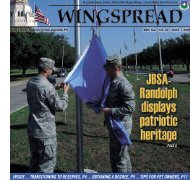AETC commander immersed in Lackland fundamentals
AETC commander immersed in Lackland fundamentals
AETC commander immersed in Lackland fundamentals
- No tags were found...
You also want an ePaper? Increase the reach of your titles
YUMPU automatically turns print PDFs into web optimized ePapers that Google loves.
MARCH 27, 2009TALESPINNERPAGE 15COURTESIES from P14charge, the first person to see asenior officer will call the group’sattention to his approach, and allmembers, if junior, will salute. If <strong>in</strong>military formation, the person <strong>in</strong>charge salutes for all members ofthe formation, unless the formationis four or less, <strong>in</strong> which case everyonesalutes.Other salut<strong>in</strong>g guidel<strong>in</strong>es<strong>in</strong>clude:• In formation – Members do notsalute or return a salute unlessgiven the command to do so.Normally the person <strong>in</strong> chargesalutes and acknowledges salutesfor the whole formation.• In public gather<strong>in</strong>gs – Salutesbetween <strong>in</strong>dividuals are notrequired <strong>in</strong> public gather<strong>in</strong>gs, suchas sport<strong>in</strong>g events or meet<strong>in</strong>gs, orwhen a salute would be <strong>in</strong>appropriateor impractical.• Staff vehicles – All military membershave the responsibility tosalute officers <strong>in</strong> staff vehicles.Staff vehicles are government vehiclesused for official bus<strong>in</strong>ess.These vehicles can be a car, van,or bus, but are usually cars. A staffvehicle may have an officer’s rankdisplayed on a bumperplate on the right frontbumper, or on a flaglocated on the rightfront fender.• Civilians –Render<strong>in</strong>g andreturn<strong>in</strong>g salutesis not required ifeither or both are<strong>in</strong> civilian attire;however, a greet<strong>in</strong>gsuch as “good morn<strong>in</strong>gsir” is appropriate.• The President – The Presidentof the United States, asCommander <strong>in</strong> Chief of the ArmedForces, is always accorded thehonor of a salute.• In a work detail – In a workdetail, <strong>in</strong>dividual workers do notsalute. The person <strong>in</strong> chargesalutes for the entire detail.• Indoors – Except for formalreport<strong>in</strong>g, and some ceremonies,salutes are not rendered.Salut<strong>in</strong>g theU. S. Flagand place your right hand overyour heart. A male wear<strong>in</strong>g a hatwill remove it and hold it <strong>in</strong> hisright hand over his heart. Femalesare not required to remove theirhats. If the flag is cased (furled andcovered with a canvas case), honorsare not required.Veterans and servicemembersnot <strong>in</strong> uniform may also render themilitary-style hand salute dur<strong>in</strong>gthe play<strong>in</strong>g of the national anthem,thanks to changes <strong>in</strong> federal lawthat took effect <strong>in</strong>October 2009.Flags on stationary flag staffsare only saluted dur<strong>in</strong>g Reveille,Retreat or special ceremonies. Anexception is when board<strong>in</strong>g a shipof the U.S. Navy it is customary tofirst salute the “ensign” (U.S. flag)fly<strong>in</strong>g aft prior to salut<strong>in</strong>g the officerof the deck and request<strong>in</strong>g permissionto board the vessel.The ceremonial occasionswhen the salute is rendered,outdoors only,<strong>in</strong>clude the pass<strong>in</strong>g ofthe uncased colors,the play<strong>in</strong>g of“Ruffles andFlourishes,” “Hail tothe Chief,” or thenational anthem ofany nation, and “Tothe Colors.”When <strong>in</strong>doors and <strong>in</strong>uniform or civilian clothes,face the flag, or the music if theflag is not visible, and stand atattention when the nationalanthem or “To the Colors” isplayed, do not place your handover your heart.There are two exceptions. If youare <strong>in</strong> uniform, under arms, youshould salute. The other rule iswhen you’re a spectator <strong>in</strong> uniformat a military ceremony <strong>in</strong>sidewhere outdoor rules apply. A goodexample is when a change of commandceremony planned for outdoorsis moved <strong>in</strong>side a hangardue to <strong>in</strong>clement weather.greet<strong>in</strong>g. Obviously, you shouldattempt to carry objects <strong>in</strong> yourleft arm to keep your right unencumberedfor the salute, if possible.However, you always salute asuperior if he is encumbered andyou are not, even though he can’treturn your salute. In the Air Forcewe do not salute <strong>in</strong>doors exceptdur<strong>in</strong>g a formal report. Here aresome other situations where salut<strong>in</strong>gis not appropriate:• At any time the salute is obviouslyimpractical or will seriously<strong>in</strong>terfere with the performance ofofficial duties.• Indoors, when a senior entersyour office. But you should stand.• When you are <strong>in</strong> the ranks of formation;however, if at ease <strong>in</strong> aformation, come to attention whenyou are addressed by a senior officer.• When work<strong>in</strong>g as a member of adetail or engaged <strong>in</strong> sports orsocial functions.• When you are a spectator at asports event. Come to attention ifspoken to by a senior officer.• When you are the driver of amov<strong>in</strong>g vehicle. However, whenpractical you should return thesalutes of others. This most frequentlyoccurs when an officerdriv<strong>in</strong>g a vehicle returns the securitypoliceman’s salute at the entrygate of an Air Force base.Call<strong>in</strong>g a Room toAttentionThe enlisted custom is for thefirst person to see an officer enter<strong>in</strong>gthe room to call the room toattention.If an officer of equal orhigher rank is already <strong>in</strong>the room, the room isnot called to attention.When the officerdeparts,thearrival of a senior officer, someoneshould be posted to watch for hisarrival.When the senior enters theroom, one officer will announce“Ladies and gentlemen, the command<strong>in</strong>gofficer,” or “Ladies andgentlemen, General Jones.” Allmilitary members stand at attentionuntil told to be seated.Note that common sense has aplay <strong>in</strong> decid<strong>in</strong>g when a work centeris called to attention. If br<strong>in</strong>g<strong>in</strong>gthe room to attention couldcause an adverse safety or missionimpact, it should not be done.Other Marks of RespectTraditional marks of respectalso <strong>in</strong>clude:• Juniors will stand whenaddressed by an officer senior tothem.• Juniors will walk or ride to theleft of seniors they are accompany<strong>in</strong>g.• Officers will enter aircraft andother modes of transportation <strong>in</strong><strong>in</strong>verse order of rank and shalldepart them <strong>in</strong> order of rank,unless there is special reason tothe contrary. The seniors shall beaccorded the more desirable seats.(Information compiled from AirForce Instruction 34-1201)When outdoors <strong>in</strong> uniform andan uncased U. S. flag passes by,stand at attention, salute six pacesbefore the flag is even with youand hold your salute until the flaghas passed six paces. When <strong>in</strong>civilian clothes, stand at attentionExceptions to Salut<strong>in</strong>gIf your arms are full, you are notrequired to <strong>in</strong>itiate or return asalute; however, you should alwaysextend or respond to a verbalroomis called toattention aga<strong>in</strong>.When gathered <strong>in</strong> a conferenceroom or theater await<strong>in</strong>g the


